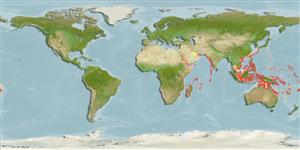Common names from other countries
Classification / Names / Names
Namen | Synonyme | Catalog of Fishes (gen., sp.) | ITIS | CoL | WoRMS
Environment: milieu / climate zone / depth range / distribution range
Ökologie
Riff-verbunden; tiefenbereich 0 - 48 m (Ref. 107548). Tropical; 36°N - 35°S, 32°E - 137°W (Ref. 848)
Indo-West Pacific.
Length at first maturity / Size / Gewicht / Alter
Maturity: Lm ? range ? - ? cm
Colonies are large, with rounded projections. Meandroid valleys give this species its resemblance to a brain. Color is consistently light brown, with a clear surface.
Occurs in most reef habitats, particularly back reef margins. On subtidal rock and rocky reefs, back and foreslope, lagoons, and outer reef channel (Ref. 98471). Form large colonies with rounded projections. A few borers or nestlers can be found on its surface (Ref. 130769).
Life cycle and mating behavior
Geschlechtsreife | Fortpflanzung | Ablaichen | Eier | Fecundity | Larven
Hermaphroditic (Ref. 113712). Mature gametes are shed into the coelenteron and spawned through the mouth. Life cycle: The zygote develops into a planktonic planula larva. Metamorphosis begins with early morphogenesis of tentacles, septa and pharynx before larval settlement on the aboral end (Ref. 833).
Babcock, R.C. 2003. (Ref. 791)
IUCN Rote Liste Status (Ref. 130435)
CITES Status (Ref. 108899)
Not Evaluated
Nutzung durch Menschen
| FishSource |
Tools
Internet Quellen
Estimates based on models
Preferred temperature
(Ref.
115969): 24.8 - 28.9, mean 27.6 (based on 370 cells).
Preiskategorie
Unknown.
